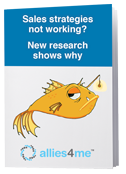
Sometimes we don’t say what we mean.
I can shoot with my left hand, I can shoot with my right hand, I’m amphibious.” – Charles Shackleford, former NC State University basketball player
Sometimes we don’t know what to ask.
If your customers know the right questions to ask, then they probably don’t need you.” – Anthony VanderLugt, PHD, former NC State University professor
VanderLugt’s words echo when businesses tell me they want to “get their social media in order.” What’s that mean?
Typically, it means that businesses know they should do more in social media, but they’re not sure what to do.
Social media became a mainstream customer channel over the last decade. But misinformation keeps businesses from asking the right questions. Let’s fix that.
Why the confusion?
We live in a sound bite culture. And the current sound bite is “you need to be on social.” So, you ask someone to do that. They say …
“Sure! We’ll increase your social presence.” And you give them money. But what did they do?
You see posts on Facebook, LinkedIn, and Twitter. So, everything is working? Right?
But what did it do for revenue? What metrics are you tracking?
Who cares, because you’re now on social media. Right? Right?
Let’s set the record straight
Start with specific goals:
- Brand awareness
- Customer service
- Direct revenue
- Don’t know (Hint: don’t spend money on unknown goals)
Social media can accomplish the goals above. But start with clearly identified goals and an agreed method for measuring those goals.
Brand awareness means you blast out content until people know who you are. But if you don’t see a corresponding increase in organic traffic or revenue, it’s unlikely you moved the needle. Companies with strong brands see high organic traffic. Make sure that is one of your metrics.
Customer service is a strategy of monitoring and responding to customer issues if they post on your social accounts. It’s a great place to find angry customers who are upset with your product or service. They want the world to know you did them wrong and they blast it out on social media. Monitor social channels and respond to customer issues. This function should be in-house or through a trained social call center. If you don’t want someone answering your business phone on your behalf, then you don’t outsource your social media customer service.
Direct sales is the easiest goal to measure and track. If you don’t have tracking in place, then make that your top priority. Make sure your ad spend delivers a positive lifetime value.
Facebook, LinkedIn, and Twitter
If you’re just getting your footing in social media, focus on the larger networks.
Facebook is clearly the largest network. Its numbers seem to be topping out and potentially dropping slightly. Even with a drop in active users, its massive user base shouldn’t be ignored.
Don’t fall into the trap of thinking Facebook is only for B2C products and services. You are always marketing to humans (B2H) and you find humans of all sorts on Facebook. Just remember their context.
The context of Facebook is human stories. Whatever you’re doing on Facebook needs to be framed in the context of human stories.
LinkedIn is growing in both audience and engagement. You absolutely need to be on LinkedIn if you’re B2B. But don’t ignore LinkedIn if you are B2C.
The context of LinkedIn is career enhancement. Your posting strategy should focus on enhancing your target audience’s career. If you’re B2C, then your strategy is about being the employer of choice.
One advantage of LinkedIn is organic posting still has value on the platform. More about that in a minute.
Let’s be honest. You should probably get Twitter advice from someone else. I’ve worked my tail off to get 64 followers, and I just lost 2.
But here’s my perspective on Twitter. It seems to be a platform that’s dying a slow death. The number of engaged users keeps dropping. They keep losing executives. And except for a 2018 rally, the stock price has consistently dropped from its post-IPO high.
It seems like the most active folks on Twitter are journalists, entertainers, marketers, and Donald Trump. If they fall in your target audience, then you should have a Twitter strategy.
Otherwise, I’d just monitor Twitter for customer service issues.
Need a gut-check on that advice? Call 10 of your customers and ask them how many times they checked Twitter in the last week.
Other platforms
There are other platforms like Instagram, Pinterest, and Snapchat.
All 3 are platforms that have a high visual component to their product or service. We don’t normally work with companies that benefit from these platforms. And Snapchat’s running out of money. You may want to focus on other platforms and see where they are a year from now.
Organic vs. paid social
Understanding the difference between organic and paid social is essential when setting your strategy.
Organic social is a product of you posting something on your timeline with the hopes that your followers will see it. LinkedIn and Twitter are good platforms for organic posting.
Don’t waste time and money on an organic strategy on Facebook. Yes, seriously! And this isn’t the first time we’ve said this.
January 8th, 2014, we posted the blog A Sober Approach to Social Media. We didn’t think organic social was a good strategy then.
Four years and three days later, Mark Zuckerberg posted this:
But recently we’ve gotten feedback from our community that public content — posts from businesses, brands and media — is crowding out the personal moments that lead us to connect more with each other.
…
Based on this, we’re making a major change to how we build Facebook. I’m changing the goal I give our product teams from focusing on helping you find relevant content to helping you have more meaningful social interactions.
…
The first changes you’ll see will be in News Feed, where you can expect to see more from your friends, family and groups.
…
As we roll this out, you’ll see less public content like posts from businesses, brands, and media.” – Mark Zuckerberg, 11 January 2018
Yes, there are exceptions to this. But remember, those are exceptions – not the norm. So, don’t waste time and money doing organic postings to your Facebook page.
Facebook is a pay-for-play platform. That means you want to run paid ads to your Facebook page. We recommend long-form ads because they help Facebook find your real audience better. The mechanics of that are beyond the scope of this blog article. But that’s what we’re having the most success with these days.
As an example, we are running long-form Facebook ads to a 2000-word landing page now. People who respond to these ads are highly engaged. The majority read all 2000 words on the landing page. (yes, we measure that)
You can run paid ads on LinkedIn as well. LinkedIn tends to be an expensive advertising platform. And LinkedIn is not a great direct-to-sale platform. It’s better for lead generation.
On any platform, you can’t run regular ads and expect them to work well. Remember the context of the platforms:
Facebook: Tell me a story about a human
LinkedIn: Help me in my career
“Lights are on” posting
There is another type of posting you should do on your social media platforms. We call that “the lights are on” posts. These are periodic posts that only serve one purpose. They let people investigating your company know that you’re still in business.
It’s like when you drive by a store. You judge if the store is open or closed based on a simple question. Are the lights on?
We recommend posting something to your social pages weekly to let your potential customers know that you are there and open for business. The context needs to be consistent. Facebook is about human stories. LinkedIn is about helping people in their career.
Wrapping up
It’s great that you want to get your social media in order. Let’s start with your goals.
- Brand awareness
- Customer service
- Direct revenue
- Don’t know – No worries. We’ll help you figure that out.
Once you identify your goals, you want clear metrics that will help you know when you are or are not achieving those goals.
Start with a plan, and understand the context of the platform.
 New research shows that buyers and sellers are misaligned. Get the latest survey results from over 500 global companies.
New research shows that buyers and sellers are misaligned. Get the latest survey results from over 500 global companies.
